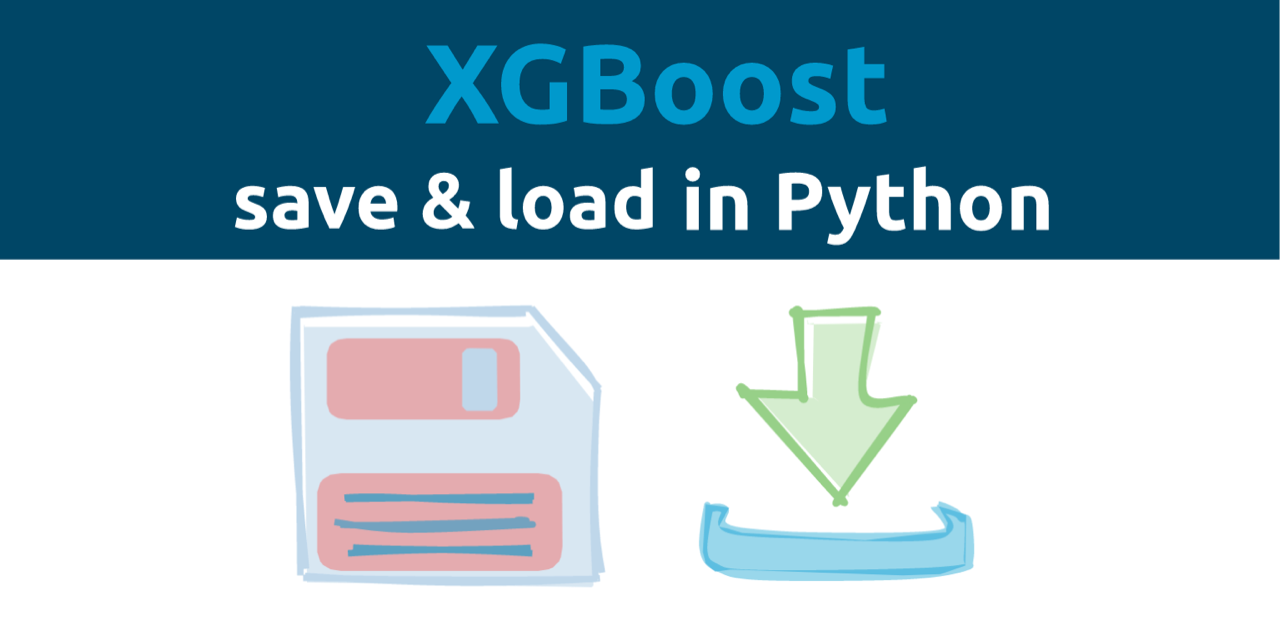How to save and load Xgboost in Python?
 Xgboost is a powerful gradient boosting framework. It provides interfaces in many languages: Python, R, Java, C++, Juila, Perl, and Scala. In this post, I will show you how to save and load Xgboost models in Python. The Xgboost provides several Python API types, that can be a source of confusion at the beginning of the Machine Learning journey. I will try to show different ways for saving and loading the Xgboost models, and show which one is the safest.
Xgboost is a powerful gradient boosting framework. It provides interfaces in many languages: Python, R, Java, C++, Juila, Perl, and Scala. In this post, I will show you how to save and load Xgboost models in Python. The Xgboost provides several Python API types, that can be a source of confusion at the beginning of the Machine Learning journey. I will try to show different ways for saving and loading the Xgboost models, and show which one is the safest.
Useful links:
- Xgboost documentation: https://xgboost.readthedocs.io,
- Xgboost GitHub: https://github.com/dmlc/xgboost,
- Xgboost website: https://xgboost.ai/.
The Xgboost model can be trained in two ways:
- we can use python API that connects Python with Xgboost internals. It is called
Learning APIin the Xgboost documentation. - or we can use Xgboost API that provides scikit-learn interface. The documentation of scikit-learn compatible API.
Depending on which way you use for training, the saving will be slightly different.
We are using Xgboost in version 2.0.0 in this article.
Let's create the data:
import xgboost as xgb from sklearn.datasets import make_classification from sklearn.model_selection import train_test_split print(xgb.__version__) # I'm using Xgboost in version `2.0.0`. # create example data X, y = make_classification(n_samples=100, n_informative=5, n_classes=2) X_train, X_test, y_train, y_test = train_test_split(X, y, test_size=0.25)
Xgboost Learning API
Let's train Xgboost with learning API:
# We need to prepare data as DMatrix objects train = xgb.DMatrix(X_train, y_train) test = xgb.DMatrix(X_test, y_test) # We need to define parameters as dict params = { "learning_rate": 0.01, "max_depth": 3 } # training, we set the early stopping rounds parameter model_xgb = xgb.train(params, train, evals=[(train, "train"), (test, "validation")], num_boost_round=100, early_stopping_rounds=20)
We will get the output like below:
[0] train-rmse:0.49644 validation-rmse:0.49860
[1] train-rmse:0.49232 validation-rmse:0.49773
[2] train-rmse:0.48917 validation-rmse:0.49637
[3] train-rmse:0.48535 validation-rmse:0.49523
[4] train-rmse:0.48226 validation-rmse:0.49371
[5] train-rmse:0.47921 validation-rmse:0.49222
[6] train-rmse:0.47584 validation-rmse:0.49100
[7] train-rmse:0.47284 validation-rmse:0.48959
[8] train-rmse:0.46894 validation-rmse:0.48889
[9] train-rmse:0.46530 validation-rmse:0.48793
[10] train-rmse:0.46239 validation-rmse:0.48640
[11] train-rmse:0.45893 validation-rmse:0.48558
[12] train-rmse:0.45516 validation-rmse:0.48499
[13] train-rmse:0.45233 validation-rmse:0.48374
[14] train-rmse:0.44918 validation-rmse:0.48272
[15] train-rmse:0.44550 validation-rmse:0.48220
[16] train-rmse:0.44275 validation-rmse:0.48120
[17] train-rmse:0.43935 validation-rmse:0.48045
[18] train-rmse:0.43666 validation-rmse:0.47911
[19] train-rmse:0.43343 validation-rmse:0.47847
[20] train-rmse:0.43011 validation-rmse:0.47780
[21] train-rmse:0.42749 validation-rmse:0.47674
[22] train-rmse:0.42434 validation-rmse:0.47616
[23] train-rmse:0.42111 validation-rmse:0.47556
[24] train-rmse:0.41856 validation-rmse:0.47449
[25] train-rmse:0.41516 validation-rmse:0.47418
[26] train-rmse:0.41213 validation-rmse:0.47368
[27] train-rmse:0.40900 validation-rmse:0.47316
[28] train-rmse:0.40654 validation-rmse:0.47218
[29] train-rmse:0.40359 validation-rmse:0.47173
[30] train-rmse:0.40033 validation-rmse:0.47154
[31] train-rmse:0.39763 validation-rmse:0.47090
[32] train-rmse:0.39526 validation-rmse:0.47020
[33] train-rmse:0.39208 validation-rmse:0.47007
[34] train-rmse:0.38925 validation-rmse:0.46972
[35] train-rmse:0.38632 validation-rmse:0.46936
[36] train-rmse:0.38404 validation-rmse:0.46873
[37] train-rmse:0.38128 validation-rmse:0.46843
[38] train-rmse:0.37843 validation-rmse:0.46814
[39] train-rmse:0.37572 validation-rmse:0.46788
[40] train-rmse:0.37352 validation-rmse:0.46710
[41] train-rmse:0.37054 validation-rmse:0.46709
[42] train-rmse:0.36810 validation-rmse:0.46656
[43] train-rmse:0.36595 validation-rmse:0.46578
[44] train-rmse:0.36304 validation-rmse:0.46580
[45] train-rmse:0.36047 validation-rmse:0.46551
[46] train-rmse:0.35780 validation-rmse:0.46532
[47] train-rmse:0.35573 validation-rmse:0.46480
[48] train-rmse:0.35322 validation-rmse:0.46465
[49] train-rmse:0.35042 validation-rmse:0.46474
[50] train-rmse:0.34816 validation-rmse:0.46432
[51] train-rmse:0.34616 validation-rmse:0.46384
[52] train-rmse:0.34343 validation-rmse:0.46396
[53] train-rmse:0.34103 validation-rmse:0.46376
[54] train-rmse:0.33909 validation-rmse:0.46311
[55] train-rmse:0.33661 validation-rmse:0.46304
[56] train-rmse:0.33427 validation-rmse:0.46322
[57] train-rmse:0.33183 validation-rmse:0.46316
[58] train-rmse:0.32995 validation-rmse:0.46283
[59] train-rmse:0.32737 validation-rmse:0.46301
[60] train-rmse:0.32511 validation-rmse:0.46311
[61] train-rmse:0.32275 validation-rmse:0.46309
[62] train-rmse:0.32094 validation-rmse:0.46252
[63] train-rmse:0.31844 validation-rmse:0.46274
[64] train-rmse:0.31625 validation-rmse:0.46298
[65] train-rmse:0.31397 validation-rmse:0.46301
[66] train-rmse:0.31183 validation-rmse:0.46326
[67] train-rmse:0.31010 validation-rmse:0.46273
[68] train-rmse:0.30770 validation-rmse:0.46298
[69] train-rmse:0.30549 validation-rmse:0.46304
[70] train-rmse:0.30342 validation-rmse:0.46319
[71] train-rmse:0.30175 validation-rmse:0.46289
[72] train-rmse:0.29943 validation-rmse:0.46317
[73] train-rmse:0.29730 validation-rmse:0.46326
[74] train-rmse:0.29529 validation-rmse:0.46355
[75] train-rmse:0.29368 validation-rmse:0.46328
[76] train-rmse:0.29143 validation-rmse:0.46358
[77] train-rmse:0.28937 validation-rmse:0.46370
[78] train-rmse:0.28743 validation-rmse:0.46389
[79] train-rmse:0.28589 validation-rmse:0.46346
[80] train-rmse:0.28371 validation-rmse:0.46379
[81] train-rmse:0.28172 validation-rmse:0.46392
[82] train-rmse:0.27984 validation-rmse:0.46424
We can see that there are trained 83 trees. Let's check the optimal tree number:
model_xgb.best_iteration # result > 63
I will show you something that might surprise you. Let's compute the predictions:
model_xgb.predict(test) # result > array([0.37061724, 0.23207052, 0.40625256, 0.28753477, 0.516009 , 0.23207052, 0.5257586 , 0.3699053 , 0.35333863, 0.75463873, 0.2718957 , 0.74117696, 0.7306833 , 0.2913912 , 0.5032675 , 0.35681653, 0.5884493 , 0.28920862, 0.516009 , 0.5212214 , 0.23207052, 0.23207052, 0.7434248 , 0.23207052, 0.28405687], dtype=float32)
Again, let's compute the predictions with an additional parameter ntree_limit:
model_xgb.predict(test, iteration_range=(0, model_xgb.best_iteration+1)) # result > array([0.39995873, 0.2791416 , 0.4064596 , 0.32292357, 0.53171337, 0.2791416 , 0.52718186, 0.39682925, 0.38713488, 0.71079475, 0.29251572, 0.7001796 , 0.68683934, 0.3316707 , 0.5189719 , 0.39087865, 0.5695737 , 0.33654556, 0.53171337, 0.5270995 , 0.2791416 , 0.2791416 , 0.6995808 , 0.2791416 , 0.3191798 ], dtype=float32)
You see the difference in the predicted values! By default, the predict() method is not using an optimal number of trees. You need to specify the number of trees by yourself, by setting the iteration_range parameter.
Save the Xgboost Booster object
There are two methods that can make the confusion:
save_model(),dump_model().
For saving and loading the model the save_model() should be used. The dump_model() is for model exporting which should be used for further model interpretation, for example visualization.
OK, so we will use save_model(). The next thing to remember is the extension of the saved file. If it will be *.json then the model will be saved in json format. Otherwise, it will be saved in text format.
Let's check:
# save to JSON model_xgb.save_model("model.json") # save to text format model_xgb.save_model("model.txt")
There is a difference in file size. The model.json file has 100.8 KB and the model.txt file has 57.9 KB (much smaller).
Let's load the model:
model_xgb_2 = xgb.Booster() model_xgb_2.load_model("model.json")
You can also load the model from the model.txt file. They will be the same. And now the surprise, let's check the optimal number of trees:
model_xgb_2.best_iteration # result > --------------------------------------------------------------------------- AttributeError Traceback (most recent call last) <ipython-input-139-4b9915a166cd> in <module> ----> 1 model_xgb_2.best_iteration AttributeError: 'Booster' object has no attribute 'best_iteration'
That's right the best_iteration variable is not saved. You must be very careful with this API. Let's take a look at scikit-learn compatible API (it is much user friendly!).
Xgboost with Scikit-learn API
Let's train the Xgboost model with scikit-learn compatible API:
# training model = xgb.XGBRegressor(n_estimators=100, max_depth=3, learning_rate=0.01, early_stopping_rounds=20) model.fit(X_train, y_train, eval_set=[(X_train, y_train), (X_test, y_test)])
The output from training is the same as earlier, so I don't post it here. Let's check the predict():
model.predict(X_test) # result > array([0.39995873, 0.2791416 , 0.4064596 , 0.32292357, 0.53171337, 0.2791416 , 0.52718186, 0.39682925, 0.38713488, 0.71079475, 0.29251572, 0.7001796 , 0.68683934, 0.3316707 , 0.5189719 , 0.39087865, 0.5695737 , 0.33654556, 0.53171337, 0.5270995 , 0.2791416 , 0.2791416 , 0.6995808 , 0.2791416 , 0.3191798 ], dtype=float32)
... and predict() with ntree_limit:
model.predict(X_test, iteration_range=(0, model.best_iteration+1)) # result > array([0.39995873, 0.2791416 , 0.4064596 , 0.32292357, 0.53171337, 0.2791416 , 0.52718186, 0.39682925, 0.38713488, 0.71079475, 0.29251572, 0.7001796 , 0.68683934, 0.3316707 , 0.5189719 , 0.39087865, 0.5695737 , 0.33654556, 0.53171337, 0.5270995 , 0.2791416 , 0.2791416 , 0.6995808 , 0.2791416 , 0.3191798 ], dtype=float32)
They are the same! Nice. It is intuitive and works as expected.
Let's save the model:
# save in JSON format model.save_model("model_sklearn.json") # save in text format model.save_model("model_sklearn.txt")
The file model_sklearn.json size is 103.3 KB and model_sklearn.txt size is 60.4 KB.
To load the model:
model2 = xgb.XGBRegressor() model2.load_model("model_sklearn.json")
Check the optimal number of trees:
model2.best_iteration # result > 63
The best_iteration is saved!
Conclusions
I recommend using the Xgboost Python API that is scikit-learn compatible. It is much simpler than Learning API and behaves as expected. It is more intuitive. For saving and loading the model, you can use save_model() and load_model() methods.
There is also an option to use pickle.dump() for saving the Xgboost. It makes a memory snapshot and can be used for training resume. However, this method doesn't guarantee backward compatibility between different versions. For long-term storage the save_model() should be used.
The Xgboost is an amazing framework. However, its training may require a lot of coding (even with scikit-learn compatible API). You might be interested in trying our open-source AutoML package: https://github.com/mljar/mljar-supervised. With MLJAR you can train Xgboost with two lines of code:
automl = AutoML(algorithms=["Xgboost"]) automl.fit(X,y)
That's all. Thank you!
About the Author

Related Articles
- Extract Rules from Decision Tree in 3 Ways with Scikit-Learn and Python
- AutoML in the Notebook
- How does AutoML work?
- Machine Learning for Lead Scoring
- MLJAR AutoML adds integration with Optuna
- How to use early stopping in Xgboost training?
- CatBoost with custom evaluation metric
- The next-generation of AutoML frameworks
- MLJAR Studio a new way to build data apps
- Read Google Sheets in Python with no-code MLJAR Studio